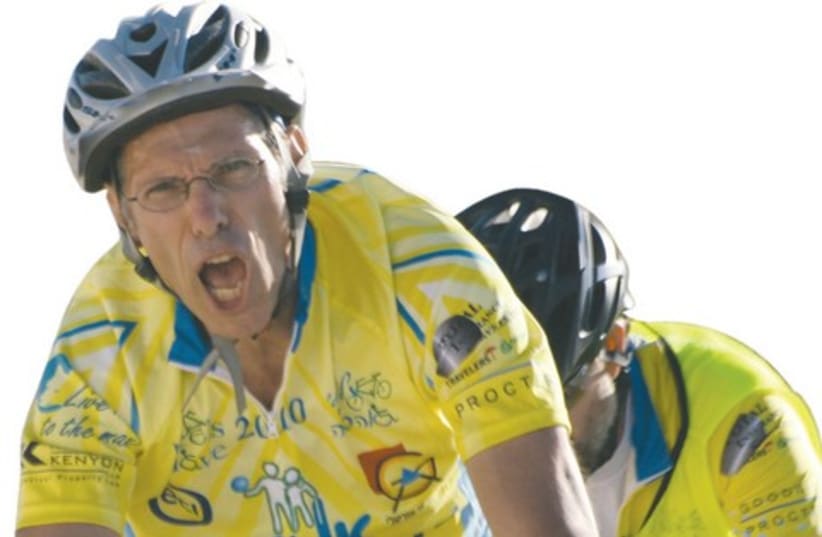CHAMPION OF SOVIET JEWRYIn April 1965, Kelter took part in the historic Jericho March in New York City organized by the Student Struggle for Soviet Jewry, bringing along a bunch of other teens he’d recruited at a B’nai B’rith Youth Organization dance the night before.Wearing a kippa for the first time outside of synagogue, he heard Reb Shlomo Carlebach sing his soon-to-be-iconic “Am Yisrael Chai.”On the bus to the follow-up Freedom Ride to Washington the next month, Rabbi Shlomo Riskin told Kelter about Yeshiva University. After visiting the campus, Kelter decided to attend college there.“I became an instant ba’al teshuva, a neophyte Orthodox, and observed my very first Shabbat in Rabbi Riskin’s home in Manhattan,” he says.Volunteering many hours that summer with the SSSJ gave Kelter another push toward aliya. “I’m asking for Soviet Jews to be let out, and I’m not going to go?” was his thinking. Just recently, he relates, he ran into Jewish Agency director (and former refusenik) Natan Sharansky. “I said, ‘Thank you for bringing me to Israel.’ He’s here because of me, and I’m here because of him.”In 1968 he spent a year at the Hebrew University, forcing himself to master Hebrew by refusing to speak English to anyone, including his American best friend and ulpan roommate.
SOCIAL WORKER, MOVER AND SHAKERThe Kelter men have all worked in insurance out of enduring gratitude to a Metropolitan Life Insurance policy that helped Kelter’s paternal grandmother with a family situation. So although Kelter is a trained social worker, he makes his living selling insurance.“I consider myself first an educator, second a social worker, and third – only if there’s a need – a salesperson,” he says. “I like to educate people and help them clarify their needs. I am impartial to the sale.”Before making aliya in 1979, he founded Social Workers for Aliya and Klita (SWAK), a support group for aliya-minded social workers and psychologists who had lived in Israel for at least six months. At its height, the group numbered 200.“Fifty individuals and families made aliya over a two-year period,” he reports proudly.One of them became his wife and mother of his three older children. Though the marriage ended, both are still in Israel.Bureaucracy in Israel was notorious in those days. “I know everyone has stories, but I found that if I related to each and every person I met as a human being, they’d bend over backwards to help. It was really a pleasure,” he says.Nevertheless, the Kelters had arrived just ahead of a job freeze. He lobbied the Knesset through a social workers’ group he had started at the Association of Americans and Canadians in Israel (AACI), in which he remains an active member, and with the support of the Israel Association of Social Workers. The social workers’ jobs were suddenly unfrozen after he and his wife appeared on national TV news.Kelter worked as a social worker and social work educator for nearly a dozen years. “Social work was very fulfilling, but not well-paying,” he comments, so he took on a second job as an insurance agent in 1985. Today he specializes in long-term care insurance.Among Kelter’s other activities, he initiated the annual Tu Bishvat Seder in 1992 at the International Jewish Vegetarian Society in Jerusalem, now called the Ginger (Zangwill) Vegetarian Community Center. He still leads this Seder annually, except for the year he was on reserve duty and led two Tu Bishvat Seders for soldiers in Gaza.Kelter gave up meat and poultry in 1991 and dairy products in 2006 out of concern for animal welfare and global warming.A self-identified feminist despite three divorces, Kelter joined the feminist Orthodox congregation Shira Hadasha. At age 60, after 33 years of spiritual wavering, he had what he calls his “real” bar mitzva.Now, just four years later, he celebrated the Jerusalem bar mitzva of his youngest child less than a month after becoming a firsttime grandfather.WHEELS OF LOVE “Ten years ago I heard about Alyn Hospital and went to visit. I was just blown away by the love and care of the children there,” says Kelter of the Jerusalem facility that is Israel’s only pediatric and adolescent rehabilitation center for children with a range of congenital and acquired conditions.He bought a bicycle specifically to participate in the annual Alyn Wheels of Love charity ride, though he hadn’t cycled in 40 years. He has since raised NIS 200,000 for Alyn’s children by spinning his wheels from the North to the South.“This year will be my ninth ride in a row.My trademark is that I sing while riding up the hills,” says Kelter. “The steeper the mountain, the more I sing.”
PUBLIC ACTIONKelter was among the Tel Aviv crowd when prime minister Yitzhak Rabin was assassinated. “Afterward, the Left was calling all the Right murderers, and I thought that was just terrible,” he says.True to form, he did not merely fret silently but founded the Learning to Live Together project through AACI.“We had guided public discussions where we invited people from the Left and from the Right to talk and listen.” The project petered out after six months, but Kelter felt it helped foster tolerance.After the Versailles wedding hall in Jerusalem collapsed in 2001, killing 23 people people and injuring more than 300, Kelter formed a public committee to petition the government to enact a universal building code. Soon afterward, again through AACI, he established a water conservation educational program.“I would like to help create a loving and caring society that will be a light unto the nations,” he says. “When I retire, I would like to do seminars to help people to circumcise their hearts to open to receive and to give love.”
